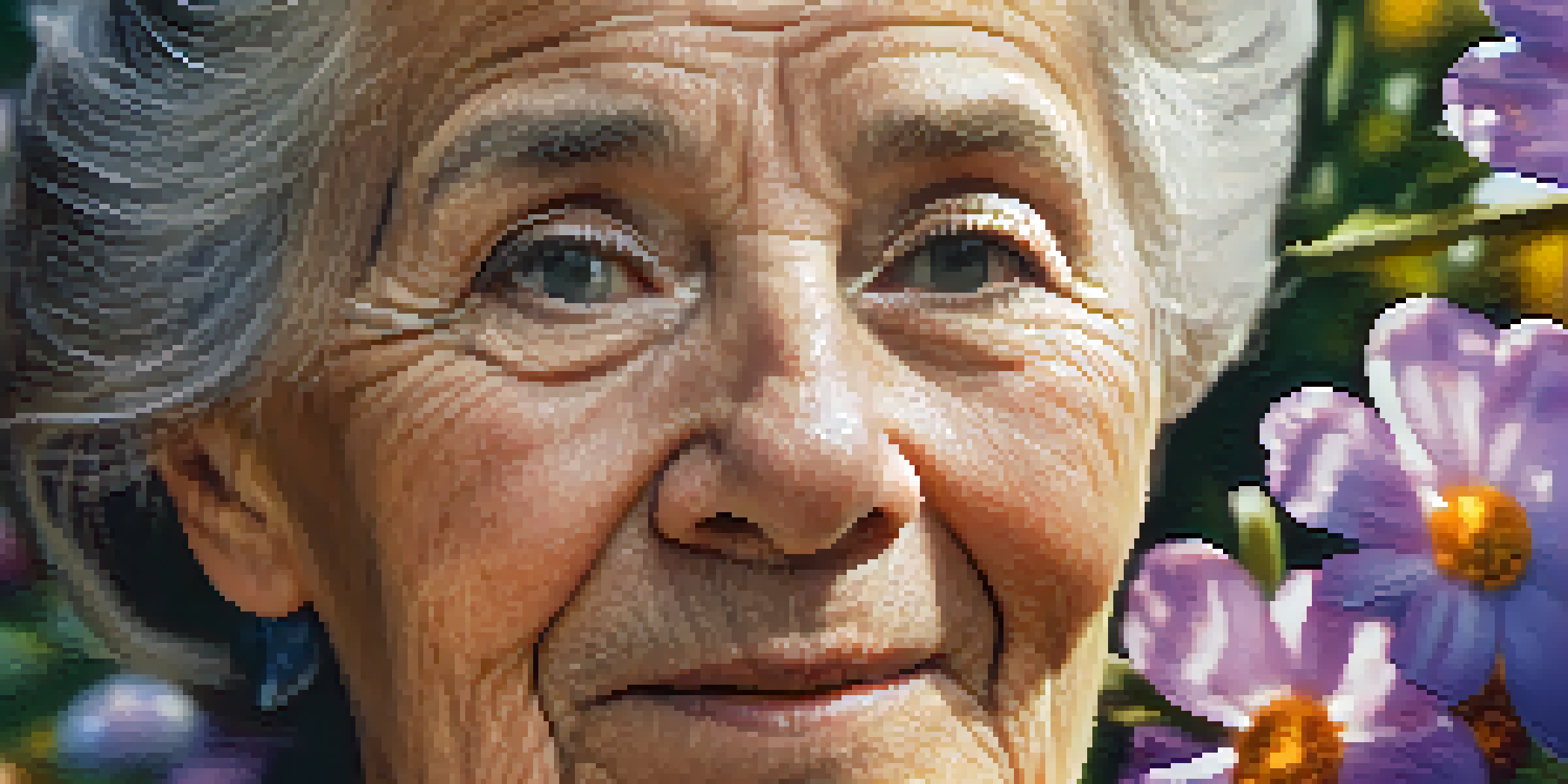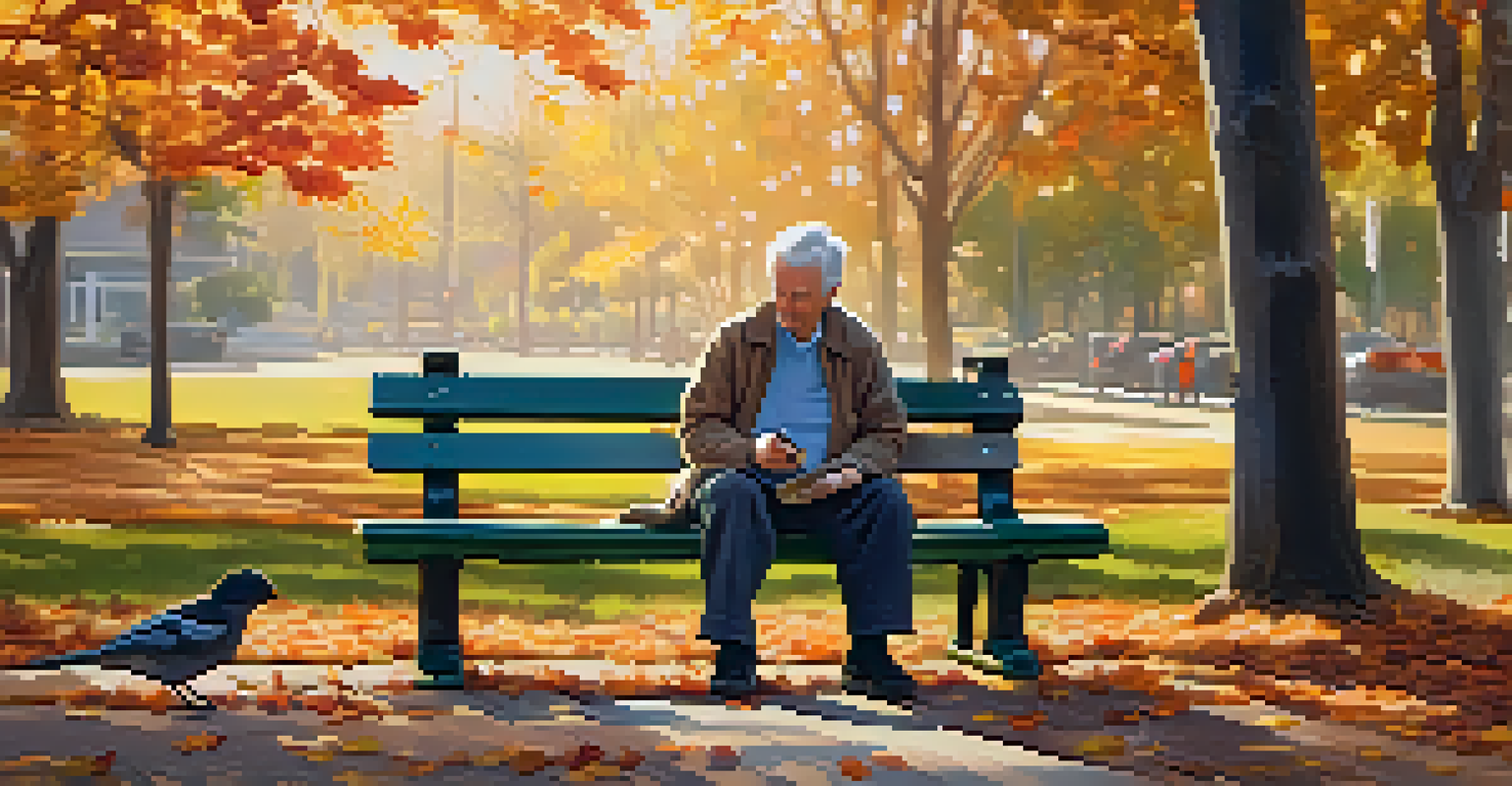Artistic Responses to Aging: A Study of Various Artists

The Creative Lens: How Artists Interpret Aging
Aging, much like art, can be interpreted in myriad ways. Artists often use their craft to explore the complexities of growing older, reflecting personal experiences and societal perceptions. This creative lens allows them to express both the beauty and the challenges that come with aging, inviting viewers to engage with these themes on a deeper level.
Aging is not lost youth but a new stage of opportunity and strength.
For example, the renowned painter Lucian Freud often depicted older subjects, celebrating their unique features and stories. His works challenge conventional standards of beauty and invite a conversation about the dignity inherent in age. Through such representations, artists can reshape our understanding of aging, making it a subject worthy of admiration rather than avoidance.
Ultimately, this creative exploration of aging serves to humanize the experience, reminding us that it's a universal journey that everyone will undertake. By engaging with these artistic interpretations, we can foster a more compassionate view of the aging process, embracing it as a natural part of life.
Photography: Capturing the Essence of Aging
Photography has a unique ability to freeze moments in time, making it a powerful medium for exploring aging. Photographers like Sally Mann have used this art form to delve into themes of mortality and the passage of time. Through her portraits, Mann captures the raw beauty and vulnerability of her aging subjects, challenging viewers to confront their own perceptions of aging.

In contrast, other photographers, such as Andrew Zuckerman, celebrate the wisdom and grace that comes with age in his series 'Wisdom.' By highlighting the stories and experiences of older individuals, Zuckerman’s work emphasizes the richness of a life fully lived. This duality in photographic representation showcases aging as both a poignant and celebratory subject.
Art's Role in Understanding Aging
Artists across various mediums explore aging, reshaping perceptions and celebrating the beauty and complexity of the aging experience.
Through these diverse photographic approaches, we glean insights into the emotional landscape of aging. Each image tells a story, inviting viewers to reflect on their own experiences and relationships with the elderly, ultimately bridging the gap between generations.
Literature: Words that Reflect the Aging Journey
Literature has long been a medium for exploring the human condition, with aging being a central theme in many works. Authors like Philip Roth and Toni Morrison have tackled the complexities of aging through their narratives, offering poignant reflections on identity, memory, and mortality. Their stories resonate with readers, providing a lens through which we can examine our own fears and hopes about growing older.
The longer I live, the more I realize the impact of attitude on life. Attitude, to me, is more important than facts.
For instance, in Roth's 'Everyman,' the protagonist's confrontation with aging and death serves as a universal reminder of our mortality. Morrison's characters often grapple with the weight of history and legacy, highlighting how aging intertwines with personal and collective narratives. These literary explorations bring depth and nuance to the conversation around aging.
Through the power of storytelling, literature allows us to empathize with the aging experience, fostering a sense of connection and understanding. By engaging with these narratives, we can come to terms with our own aging process and appreciate the wisdom that comes with time.
Film: Cinematic Representations of Aging
Film has a compelling way of portraying the aging process, often blending storytelling with visual artistry. Directors like Pedro Almodóvar and Sofia Coppola have created narratives that reflect the nuances of aging, showcasing both the joys and challenges faced by their characters. Through their films, they invite audiences to engage with the emotional realities of growing older.
In Almodóvar's 'Julieta,' the protagonist's journey through memory and loss highlights the complexities of aging and relationships. Meanwhile, Coppola’s 'Somewhere' subtly examines the emptiness that can accompany mid-life, ultimately reflecting on the importance of connection and self-discovery. These cinematic narratives provide a rich exploration of aging's multifaceted nature.
Photography Captures Aging's Essence
Through diverse photographic styles, photographers highlight the emotional landscape of aging, inviting reflection on personal and generational connections.
By engaging with film, audiences are encouraged to reflect on their own lives and relationships. The stories unfold on screen, prompting us to consider our perspectives on aging and the lessons that come with it, enhancing our understanding of this universal experience.
Dance: Movement and the Aging Body
Dance offers a visceral and dynamic approach to exploring aging, emphasizing the body's movement over time. Choreographers like Martha Graham and Pina Bausch have created works that reflect the physicality of aging, celebrating the strength and grace that can exist at any age. Through their performances, they challenge stereotypes about the limitations of the aging body.
For instance, Graham’s choreography often incorporated older dancers, showcasing their experience and artistry. This inclusion not only enriches the performance but also sends a powerful message about the value of older bodies in the dance world. Such representations encourage audiences to appreciate the beauty of movement, regardless of age.
Through the lens of dance, we can experience the aging process in a profound way. The expressive nature of movement allows for a celebration of life’s stages, inviting viewers to reflect on their own journeys and the wisdom they gain along the way.
Visual Arts: Sculpting the Narrative of Aging
Visual arts, particularly sculpture, provide a tangible way to engage with the concept of aging. Artists like Louise Bourgeois and Alberto Giacometti have created works that reflect their interpretations of aging, often conveying themes of fragility and resilience. Through their sculptures, they invite viewers to grapple with the physical manifestations of time.
Bourgeois’ work often features themes of memory and the body, reflecting on her own experiences as she aged. Giacometti’s elongated figures evoke a sense of existential inquiry, prompting contemplation on the human condition and the passage of time. These sculptural interpretations serve as a powerful reminder of the beauty found in aging.
Literature Offers Insight on Aging
Literature delves into aging's complexities, providing relatable narratives that foster empathy and understanding of the aging process.
By engaging with visual arts, we can appreciate the complexities of aging through form and texture. These sculptures provoke thought and discussion, encouraging us to confront our own feelings about aging and the narratives we create around it.
Music: Soundscapes of Aging and Experience
Music, often described as a universal language, has a unique way of expressing the emotions tied to aging. Artists like Leonard Cohen and Joan Baez have woven themes of aging into their lyrics, reflecting on love, loss, and the passage of time. Their songs resonate deeply, providing a soundtrack to the experiences of growing older.
For example, Cohen’s haunting melodies often explore themes of mortality and introspection, inviting listeners to reflect on their own lives. Baez, with her rich storytelling, captures the essence of resilience and hope through her music. These artists remind us that aging is not just about decline, but also about the richness of experience and the beauty of memory.

Through music, listeners can find solace and understanding in the shared experience of aging. The emotional power of song can evoke nostalgia and connection, reminding us that while aging is inevitable, it is also a journey filled with moments worth celebrating.